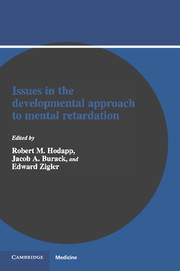Book contents
- Frontmatter
- Contents
- Preface
- Contributors
- Part 1 Developmental theory
- Part 2 Applying developmental theory to different types of retarded individuals
- 7 Cultural–familial mental retardation: A developmental perspective on cognitive performance and “helpless” behavior
- 8 The organization and coherence of developmental processes in infants and children with Down syndrome
- 9 Developmental issues in fragile X syndrome
- 10 Deviance and developmental approaches in the study of, autism
- 11 The issues of multiple pathways in the development of handicapped children
- 12 Summing up and going forward: New directions in the developmental approach to mental retardation
- Author index
- Subject index
11 - The issues of multiple pathways in the development of handicapped children
from Part 2 - Applying developmental theory to different types of retarded individuals
Published online by Cambridge University Press: 07 September 2010
- Frontmatter
- Contents
- Preface
- Contributors
- Part 1 Developmental theory
- Part 2 Applying developmental theory to different types of retarded individuals
- 7 Cultural–familial mental retardation: A developmental perspective on cognitive performance and “helpless” behavior
- 8 The organization and coherence of developmental processes in infants and children with Down syndrome
- 9 Developmental issues in fragile X syndrome
- 10 Deviance and developmental approaches in the study of, autism
- 11 The issues of multiple pathways in the development of handicapped children
- 12 Summing up and going forward: New directions in the developmental approach to mental retardation
- Author index
- Subject index
Summary
Multiple pathways, a term found in the developmental literature, suggests that major end-points in development (e.g., sensorimotor period, preschool years) as well as particular attainments (e.g., object permanence, problem solving, conservation) can be reached without necessarily invoking specific systems or processes for information intake and encoding. Although some might have reservations about this premise (Gesell, 1948; Piaget, 1970), recent research provides partial support. The perception of form can be obtained by visual or manual exploration, or both (e.g., see Spelke, 1987). Similarly, the functional fine tuning of learning and retrieval may occur by using auditory rehearsal strategies, reliance on visual clues, or invention of acronyms (e.g., see Brown, Bransford, Ferrara, & Campione, 1983).
The concept of multiple (or alternative) pathways has been used to account for the developmental attainments of handicapped children (e.g., Kopp & Shaperman, 1973). However, systematic, comprehensive studies that test models of multiple pathways have yet to be made, although Millar's (1988) programmatic research with the congenitally blind is an important beginning. Millar has focused on spatial abilities, and argues on the basis of data that vision is neither necessary nor sufficient for coding spatial information. She does state that sense modalities are often specialized, but systems do interconnect such that there is the possibility of overlapping inputs. Millar further states that “… sensory information is normally convergent and complementary, and can be sampled at any point during processing” (p. 71).
- Type
- Chapter
- Information
- Issues in the Developmental Approach to Mental Retardation , pp. 272 - 293Publisher: Cambridge University PressPrint publication year: 1990
- 4
- Cited by



